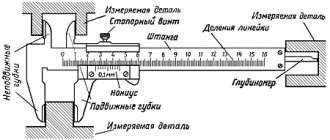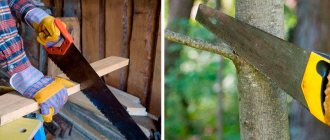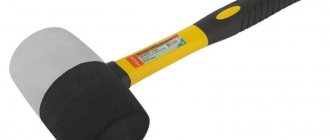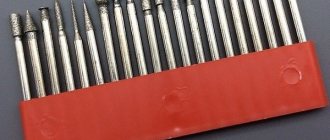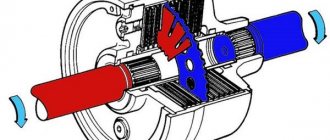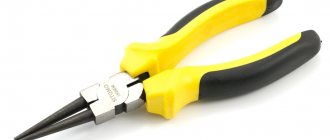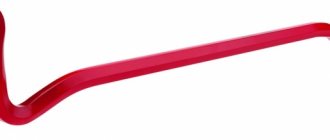In construction, mechanical engineering, agriculture, manufacturing and even in everyday life, for various reasons it is necessary to measure the humidity of gases and materials.
For these purposes, a moisture meter is used, as well as its popular subtype - a hygrometer.
The latter can be divided into many types, depending on the method of measuring humidity and various design features.
It is interesting that this is a device that is simple from a technical point of view, but extremely useful, and sometimes simply necessary from a practical point of view.
Purpose of hygrometers
Initially, a hygrometer, which is also sometimes called a hygroscope, was exclusively laboratory equipment designed to literally determine the amount of moisture in gases.
Today, this name is given to devices that can determine:
- The absolute humidity of a gas mixture, that is, the density of water vapor present.
- Relative humidity is the ratio of the amount of water contained in a gas mixture at its specific temperature to the maximum possible amount of water in the same mixture at the same temperature.
- Dew point is the temperature at which the saturation of a gas mixture with water vapor becomes maximum if, other things being equal, they are constantly contained in this mixture. To put it simply, this is the temperature at which moisture condensation begins at a certain pressure value.
It is interesting that the readings of one type of hygrometer can be easily converted into the results of another through simple calculations, or by using ready-made special tables, since all three given values are related.
The number of different methods for taking readings is also impressive.
For example, some are based on the conductivity of air, others on the content of salts and polymers.
Most hygrometers are designed to determine the humidity of a well-known gas mixture - air.
This is important both in everyday life and in various areas of human activity.
It has been proven that excess or insufficient humidity has a negative impact on human health, so it is important to adjust its level to ensure comfort.
A hygrometer is often used by builders when performing plastering and painting work to check air humidity for compliance with building codes.
The same applies to wallpapering, laying laminate flooring, and caring for already laid parquet.
Over time, humidity meters began to be called hygrometers not only for gas mixtures, but also for various materials.
For example, on sale you can find models for wood and other building materials, including hardening ones, such as concrete.
Others are designed specifically for grain.
Still others are used to analyze petroleum products and, in fact, the oil itself.
As you can see, moisture meters are used everywhere, and there are many types on the market.
Hydrometer Testo 645
Dual-channel measurement of T and humidity. Very accurate humidity measurement up to ± 1% rF with internal measurement memory. How to use a hygrometer? Testo 645 displays the following values at the touch of a button: humidity, dew point, enthalpy and temperature. Convenient evaluation of measurement data with transfer to a PC and indicating the measurement location. Maximum humidity 100%. Minimum humidity 0%. Temperature from -50°C to +150°C.
Design, characteristics and principle of operation
A modern hygrometer consists of a housing, inside of which the actual mechanism that determines humidity is hidden, the design of which depends on the type of device.
Electronic models require a power source to operate, for example, batteries, which are also hidden in the case; such options are called wireless.
There are also wired hygrometers, where the indicator is located at the end of the wire, which allows you to take measurements in hard-to-reach places.
Network models of this device that operate from an electrical network are also called wired.
There are also battery-powered versions of the devices.
Digital hygrometers display the humidity level on a display.
Dial, that is, analog models have a pointer and a dial.
A sensor is in contact with the environment under study, which can be internal - to determine the humidity of the surrounding air, and external - to take measurements at a specific point.
Material
In the manufacture of the hygrometer housing, plastic is often used, less often metal and wood.
If the design has a dial, it is covered with transparent plastic or glass.
Dimensions and weight of hygrometers
It should be taken into account that hygrometers can be manufactured as separate devices, or they can be mounted in a housing with other devices, for example, as part of a home weather station.
In most cases, a humidity meter is a compact device with a wall or tabletop design.
Weather stations usually have dimensions comparable to wall clocks and weigh up to 1 kg or more.
Desktop analog models usually have a dial with a diameter of about 80 – 100 mm.
Digital desktop instruments are comparable in size to a calculator with a height and width of 110 x 100 mm on average.
In a pocket-sized version, digital moisture meters are comparable in both appearance and dimensions to individual breathalyzers.
Metric system and uncertainty
In most cases, hygrometers determine the relative humidity of the air, and therefore the result is shown as a percentage.
In this case, the dial is marked from 0 to 100. However, this does not apply to all devices.
Thus, models showing the dew point display the result, as a rule, in degrees Celsius.
To indicate absolute humidity, the SI (International System of Units) uses kg/m3, while the absolute physical unit, CGS (centimeter-gram-second), which preceded the SI, uses g/cm3.
As for the instrument error, it greatly depends on the type of sensor used, or more precisely on its accuracy class.
Speaking about digital devices, their manufacturers usually indicate an accuracy of 1%.
However, if the model does not have a passport where the error is indicated, then you can safely doubt the hygrometer readings.
Cheap options in most cases cannot boast an error of less than 5%. This means that 70% humidity could actually be 72% or 68%.
For this reason, it is important to buy a device with a passport confirming the characteristics.
Important!
Accuracy is also affected by a dead battery, or simply poor contact.
Obviously, the most accurate devices are those with the smallest error.
Analog hygrometers are the least accurate, therefore they are not used for important measurements; they serve more as indicators.
The error of such devices is 2% - 5%, which is in principle sufficient for everyday tasks.
A precision hygrometer is a high-precision digital instrument, the error of which does not exceed 0.1%.
Measuring depth and range
Measurement depth parameters apply only to contact hygrometers, and they depend on the length of the probes (needles) that are immersed in the material being tested.
This figure for hygrometers for soil, grain and other bulk materials can reach 300mm.
The scale range of hygrometers usually starts from 0% and ends at 100% humidity, sometimes 20% - 100%.
In terms of options for testing different materials, a range from 0% to the upper limits of 50% - 65% is quite sufficient.
Multifunctional instruments have several measuring ranges, depending on the materials being worked with, for example, 0% - 35% for concrete and 0% - 50% for lumber.
Additional functions
Hygrometers are often equipped with additional functionality.
Some models are combined in one housing with other measuring instruments, for example, dial or electronic thermometers.
In other words, they are capable of measuring both air humidity and temperature, and can be equipped with a clock, or vice versa - the latter acts as the main measuring device.
Other hygrometers are capable of not only displaying humidity, but also notifying about violations of the microclimate in the room.
This is possible thanks to light or sound signals built into the device.
These functions allow you to notice the problem in a timely manner and fix it.
Some of these devices support independent setting of a safe range of indicators, within which the signal will not be triggered.
Manufacturers of digital hygrometers often equip their products with a pressure indicator, which makes it possible to additionally measure the absolute pressure in rooms.
Battery devices have an indication of the battery charge level and high noise immunity.
An additional function is the ability to receive and transmit information to a computer.
Among the useful functions not directly related to measurements, we should note the screen backlight, which can be implemented in different ways.
For some, the backlight is turned on by a button, while for others it starts automatically when the light falls below a certain level.
Pointer models are sometimes equipped with dial illumination.
Additionally, hygrometers can be equipped with an alarm clock, a calendar, and even a reading recording function that can automatically mark minimum and maximum values.
Moisture meter MODEL C-02
The device measures CO2, T and humidity, with a triple LCD display. How to use a hygrometer? MODEL C-02 T wet bulb thermometer and dew point function. Dual band infrared CO2 sensor.
The device performs:
- Automatic measurement log keeping with data transfer to a PC. Data Hold: Freezes the display.
- Low battery indicator.
- Operating temperature: 5°C to 50°C.
- Operating humidity: -10 to 90% humidity.
- Storage humidity: 10 to 90% relative humidity.
- Accuracy: CO2: ±3% or ±50ppm,
- Humidity: ±5% RH,
- Temperature: ±1 C, ±1.8 F.
- Automatic memory capacity: 20,000 measurements.
- Serial interface RS-232.
GOST
For some types of hygrometers, GOSTs have been developed that regulate the methods of their verification:
- GOST 8.472-2013 – for piezosorption hygrometers.
- GOST 8.547-86 regulates the verification scheme and primary standard for measuring instruments regarding gas humidity, including hygrometers and hygrographs.
- GOST R 8.881-2015 regulates verification methods for moisture meters of lumber and wood.
- GOST 8.519-84 – for diel-metric moisture meters of building materials.
- GOST R 8.781-2012 – for moisture meters of grain and grain products.
The following GOSTs regulate technical requirements and conditions:
- GOST R 8.758-2011 – for coulometric hygrometers.
- GOST 29027-91 – test methods and general technical requirements for moisture meters of bulk and solid substances.
- GOST 21196-75 – for neutron moisture meters.
Instruments included in the State Register of SI, used for measurements in the field of GROEI, must undergo mandatory annual periodic verification, which, like the primary verification, is carried out by special accredited bodies.
Since mechanical hygrometer models are sensitive to vibrations and shocks, after purchase they require calibration, which is performed with a special screw, usually located on the back of the case.
The meaning of this action is to place the device in an environment with a previously known humidity, after which its value is adjusted.
The quality of the hygrometer can be guaranteed, first of all, by the SI type approval certificate.
Marking
Moisture meters are marked in accordance with GOST 26828. The marking must contain the manufacturer's trademark, the designation of the hygrometer, its serial number and date of manufacture, as well as the State Register mark.
The consumer packaging, that is, the packaging, indicates the designation of the device and the trademark.
If the moisture meter has passed acceptance tests, a seal is placed on it.
Portable
The main areas of application for portable hygrometers are the oil and gas and petrochemical industries. Using such a device, the microhumidity of gas in cylinders or pipelines is determined. They can operate over a wide temperature range and output humidity in different units of measurement. The compactness of the hygrometer allows you to easily take measurements at the right points.
Types of hygrometers and their prices
Hygrometers differ in their measurement methods into many types, so they are:
Psychrometric
The simplest options for indirectly measuring air humidity based on a decrease in the temperature of a wetted body, which acts as a temperature sensor.
A psychrometer has not one thermometer, as is the case with a classic thermometer-hygrometer combination, but two, usually toluene: dry - displays the ambient temperature, wet - with a capillary thickening placed in a wetted wick, will always show a lower temperature due to evaporation liquid and intensive cooling.
Based on the temperature difference between these thermometers, the relative humidity of the surrounding gaseous medium is determined, and for this there is a special table, which is always attached next to the thermometers on a plastic or wooden holder.
Weight
Used to find absolute humidity.
The design includes tubes with a hygroscopic substance.
There is a special pump for air intake.
Humidity is calculated based on the known volume of air, as well as the mass of the system before and after the test.
Film
A pointer instrument in which the sensor is a special organic film connected to the arrow, which changes its position relative to the dial scale when the length of the first one changes.
Hairline
Similar to the previous option, however, instead of film, it uses low-fat hair with properties similar to film models.
Electrolytic
It is based on a polystyrene, glass or any electrical insulating plate coated with a layer of electrolyte.
The electrolyte resistance directly depends on the moisture content in the air mass.
Ceramic
The sensor is a porous and hard special ceramic mixture that can change its electrolytic resistance depending on humidity.
Condensation (Lambrecht)
Allows you to use a special table to find humidity at a known dew point.
Structurally, it consists of a small mirror, a device for cooling it and an ordinary thermometer.
Cooling the mirror leads to fogging, and this moment is recorded, and for the convenience of determining it, a metal ring acts as a reflection standard.
There is another type of hygrometer - electronic, which includes the following several main subspecies:
Optoelectronic
With a cooled mirror for finding the dew point, which is then heated, which allows you to determine humidity with high accuracy.
Capacitive
The design includes an oxide capacitor, the capacitance value of which is directly affected by the amount of moisture contained in the air.
Such models require mandatory periodic calibration, since the detector capacity inevitably decreases over time.
Resistive
The work is based on the dependence of the electrical resistance of polymers and salts on the level of air humidity.
So the first parameter directly depends on the second.
According to the method of displaying information, a hygrometer can be:
Analog
A classic device with an arrow and a dial.
Digital
In most cases, a multifunctional device capable of displaying measurement results in numerical form on a built-in LCD display.
By design, a hygrometer can be:
Contact
Used to determine the moisture level of any materials.
From the name it is clear that, for example, to determine the humidity of wooden products, the device must be leaned against the wood with sensors.
Vivid examples of devices of this type are an induction hygrometer - sensors are placed on the surface, as well as a needle hygrometer - sensors in the form of two needles are immersed in the material being studied.
Such equipment is used in warehouses, in laboratories when receiving building materials, in the petrochemical industry and agriculture.
Contactless
Designed to determine the humidity of gas and gas mixtures, including air.
The principle of operation is based on the ability of some substances to change any of their properties depending on the amount of moisture contained.
Hygrometers are also distinguished by their purpose, so they are for:
- soil;
- grains;
- cigars;
- building materials (concrete, wood, sand);
- baths (saunas);
- residential and warehouse premises.
- weather stations;
According to the type of design, the hygrometer can be:
Desktop
Small household version with a special stand or legs for installation on a table.
Wall
It has a flat body and a hole on the back that allows it to be placed on the wall.
It can be used as a household device for displaying current values, or as a professional temperature and humidity recorder, also called a logger.
The latter are used to collect data, for example, on the storage conditions of raw materials in warehouses.
Portable
A digital, portable version that is small in size and designed to be carried with you and used in the field.
Stationary
Professional laboratory equipment, a set of which can weigh up to 50 kg.
A striking example is a coulometric (electrolysis) hygrometer for measuring the absolute humidity of gases by measuring the electrolysis current of water extracted from them.
In addition to models made in an individual case, there are multifunctional versions, that is, combined with other measuring instruments, and in terms of design they are very different.
A simple example is a thermohygrometer, which combines the functions of a thermometer and a hygrometer.
It can be either analog or electronic.
A special case of the latter is the so-called stick thermohygrometer, designed to measure humidity and temperature in hard-to-reach and narrow places due to the presence of an elongated probe movably attached to the main unit.
Classic mechanical hygrometers that do not have additional functions can be purchased for 500 rubles, and electronic models will cost from 1 thousand rubles.
The cost of home weather stations, which include, in addition to a hygrometer, a thermometer and a barometer, starts at 5 thousand rubles, and their digital versions can cost the buyer 35 thousand rubles.
Moisture meter and its features
In order to learn how to use a hygrometer, you need to consider the main types of devices for measuring humidity. The psychrometer consists of two separate thermometers mounted on one body. One is dry and the other is wet (wet). The lower end of the wet thermometer is covered with a special cloth that acts as a wick. It is constantly in the water, cooling and wetting the wet bulb. At temperatures (T) above the freezing point of water, the wick reduces the wet-bulb temperature, which is usually lower than the dry-bulb temperature. However, when the temperature of the air drops below zero, the wet bulb becomes covered with a thin layer of ice, and it can be warmer than the dry bulb.
Relative humidity is calculated based on the ambient temperature, dry bulb temperature, and the temperature difference between the dry and wet bulb temperatures. Relative humidity is determined using a psychrometric chart. When two temperatures are equal, the air is completely saturated, and the greater their difference, the drier the air. Using special tables, knowing the T air and the psychrometric difference (T – T m), the remaining air parameters are determined. Psychrometers are commonly used in meteorology and in the heating, ventilation and air conditioning systems of residential and public buildings.
Rules for safe operation
Although there are different types of hygroscopes, there are general rules that must be followed when using them. All equipment should be handled with care. Do not allow the device to fall.
It is also prohibited to treat the device with aggressive chemicals: for example, solutions containing alkali or acid. It is not recommended to overheat the device. The maximum permissible temperature at which the equipment can be operated is given in its accompanying instructions.
It is important to choose the right location for the hygrometer. There should be no sources of cold or heat near the equipment. The absence of vibration is important. Hygroscopes should not be placed in areas directly exposed to sunlight.
It is important to remember safety precautions when using devices containing toxic substances. For example, the thermometers of the VIT-2 psychometric apparatus are filled with toluene. This is a toxic and flammable liquid.
Therefore, it is important to prevent the device from breaking and overheating. If the tank ruptures, you can remove toluene from surrounding objects with water and detergent.
If you need to use water to measure humidity, then you should use distilled water (even if the instructions do not directly say anything about this). Unpurified tap liquid contains salts that will settle on the elements of the device, reducing its shelf life and the accuracy of the results.
Where are psychrometers used?
Psychrometers are widely used at meteorological stations for daily weather monitoring.
In many industries, psychrometers make it possible to control air humidity in warehouses to prevent damage to merchandise and other supplies from dampness. They are indispensable in greenhouses, livestock farms and poultry farms. In incubators, if the air humidity is too low, the chicks will not be able to hatch from the eggs. When the air humidity is too high, the grain in the warehouses begins to become damp and then “burn”; the seed embryos die from this. Seed material and food grains become unfit for consumption, even by animals.
In residential areas, it is advisable to control air humidity to prevent drying of mucous membranes and skin. This leads to the destruction of the protective barrier and “opening the gates” for various infections. The optimal air humidity in residential premises is 40-60 percent. If it is below normal, then people suffer from dry mucous membranes and skin, and often suffer from acute respiratory infections. If the air humidity is higher than normal, then fabrics and furniture begin to become damp, mold and other allergens multiply, and clothes deteriorate. This is why a psychrometer should be in every home.
What relative humidity should be in a living space?
Medical scientists have found that in order for a person to feel most comfortable, the room temperature should be +20 ° C and the humidity from 30 to 45%.
If the relative humidity (φ, %) is below the established range, the air is considered dry. A person who will be in such a room will feel a dry throat, he will begin to cough, and his hair and skin will become dry. Houseplants will also be susceptible to disease and will likely dry out.
On the contrary, if the actual relative humidity exceeds the upper permissible level, such a room will feel damp, and excess moisture will saturate the furniture, walls, books, bed and things. People with respiratory diseases especially suffer in damp rooms.
Humidity in the house is regulated using special dehumidifiers or humidifiers, as well as other climate control equipment, such as air heaters, air conditioners and gas boilers. It is important to know the current state of this parameter, and for this it needs to be periodically checked with a hygrometer.
